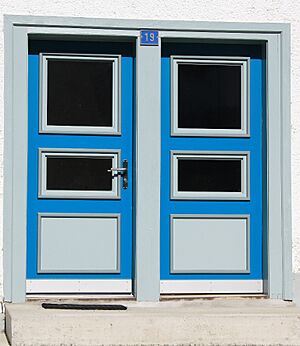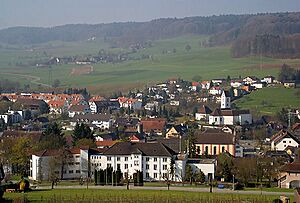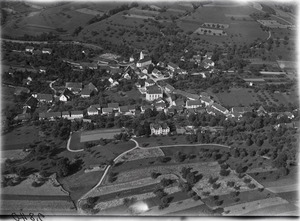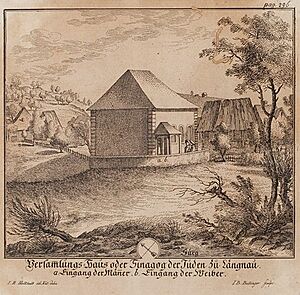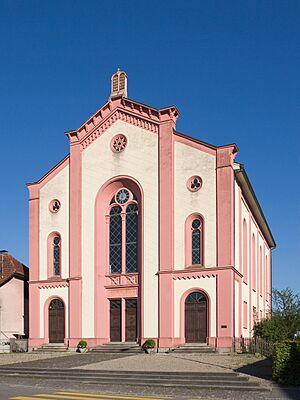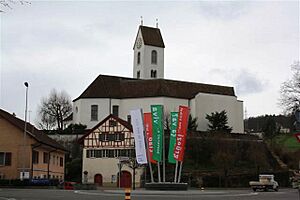Lengnau, Aargau facts for kids
Quick facts for kids
Lengnau
|
||
|---|---|---|
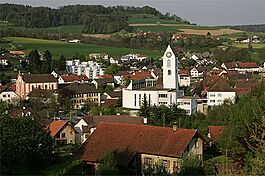 |
||
|
||
| Country | Switzerland | |
| Canton | Aargau | |
| District | Zurzach | |
| Area | ||
| • Total | 12.67 km2 (4.89 sq mi) | |
| Elevation | 415 m (1,362 ft) | |
| Population
(Dec 2020 )
|
||
| • Total | 2,770 | |
| • Density | 218.6/km2 (566.2/sq mi) | |
| Postal code |
5426
|
|
| Surrounded by | Baldingen, Böbikon, Endingen, Freienwil, Obersiggenthal, Schneisingen, Unterehrendingen, Unterendingen, Wislikofen | |
| Twin towns | Lengnau, Berne (Switzerland) | |
Lengnau is a small town, also called a municipality, in the canton of Aargau in Switzerland. It is located in the Zurzach district.
Lengnau is special because it was one of only two villages where Swiss Jews were allowed to live for a long time, from 1633 to 1874. The synagogue (a Jewish place of worship) in Lengnau is very important. It is listed as a national heritage site in Switzerland.
Contents
A Glimpse into Lengnau's Past
Lengnau has a long history. People lived here even during the Roman era, as shown by an old farm found nearby. The town was first mentioned in records in the year 798.
For many years, different groups argued over who controlled Lengnau. The Bishop of Constance and the Habsburgs both wanted rights to the area. Later, the Swiss Confederation gained full control in the late 1400s.
The main church in Lengnau, St. Martin's Church, was built in 1977. It includes parts of an older, beautiful baroque church. The Jewish community built their first synagogue in 1750 and a second one in 1847. These buildings really shaped the look of the village.
In the past, Christian residents mostly worked in farming. Jewish residents, however, were not allowed to own land or cattle. So, they worked in trade or as peddlers, selling goods from place to place.
Lengnau has grown a lot over the years. A bus line started in 1921, making it easier to travel. In 1953, a new road connected Lengnau to Baden. An industrial area opened in 1968, bringing many companies and jobs. This led to more people moving to Lengnau, and many new homes were built in the 1970s.
Jewish History in Lengnau
A special rule in 1678 allowed Jews to live in the Surb valley. After 1776, they could only live in two specific villages: Endingen and Lengnau. This changed the villages a lot. For example, Endingen never built a Christian church, only a synagogue. Christians there went to churches in nearby villages.
Jewish and Christian families often lived in the same houses. Some houses even had two separate entrances, one for Jewish families and one for Christian families.
Before 1750, Jewish people from the Surb valley were buried on a small island in the Rhein river. But this island often flooded. So, in 1750, they asked for a cemetery closer to their homes in the Surb valley.
Generally, the Jewish population was treated well. They managed their own community and had their own school. However, they were limited to certain jobs, like trading. They also had to buy "protection" letters from the authorities. It wasn't until 1876 that Jewish people in Switzerland gained full equal rights. By 1920, most Jewish residents had moved away from Lengnau.
The Plum War
In 1798, the French army came to Switzerland and created a new government called the Helvetic Republic. This new government wanted to give more rights to all people, including Jews. However, many Swiss people did not like these changes.
In 1802, some people revolted against the new government and turned against the Jewish communities. Mobs attacked and looted the Jewish villages of Endingen and Lengnau. This event is sometimes called the "Plum War."
The French leader, Napoleon Bonaparte, needed peace in Switzerland. So, in 1803, he created the Act of Mediation. This act was a compromise. It brought some stability but did not grant new rights to the Jewish people at that time.
Lengnau's Geography
Lengnau covers an area of about 12.67 square kilometers (about 4.89 square miles). A large part of this land, about 52%, is used for farming. Forests cover about 37% of the area. The rest of the land, about 9.6%, has buildings and roads.
The town is located in the beautiful Surb river valley. Lengnau includes the main village and smaller areas called hamlets, such as Degermoos, Husen, Himmelrich, and Vogelsang.
Coat of Arms
The blazon (description) of Lengnau's municipal coat of arms is: Gules a Horse trippant Argent on a Base Vert. This means it shows a silver horse walking on a green base, all on a red background.
Population and People
Lengnau has a population of about 2,434 people (as of December 2005). About 44% of the people living in Lengnau are foreign nationals.
Most people in Lengnau speak German (about 93%). Other languages spoken include Albanian and Italian.
The population has been growing. From 1997 to 2007, the number of people living in Lengnau increased by about 17%.
Here's how Lengnau's population has changed over time:
| Historical population | ||
|---|---|---|
| Year | Pop. | ±% |
| 1799 | 950 | — |
| 1850 | 1,761 | +85.4% |
| 1900 | 1,119 | −36.5% |
| 1950 | 1,355 | +21.1% |
| 1990 | 2,040 | +50.6% |
| 2000 | 2,287 | +12.1% |
Important Heritage Sites
The Synagogue on Zürichstrasse is a very important building in Switzerland. It is listed as a national heritage site.
Also, the small areas of Husen and Vogelsang, along with the entire village of Lengnau, are recognized as part of the Inventory of Swiss Heritage Sites. This means they are important places to protect because of their history and culture.
Economy and Jobs
Lengnau has a low unemployment rate, which means most people who want to work can find jobs.
In 2005, about 128 people worked in the primary economic sector, which includes farming. About 331 people worked in the secondary sector, which involves manufacturing and industry. The largest number of people, 415, worked in the tertiary sector, which includes services like shops, offices, and healthcare.
Many people who live in Lengnau travel to other towns for work. However, many people also come into Lengnau to work. About 14.5% of workers use public transportation, and 54.7% use a private car to get to work.
Religion
According to a census in 2000, most people in Lengnau are Roman Catholic (about 62%). About 20.8% belong to the Swiss Reformed Church. A small number of people also belong to the Christian Catholic faith.
Education
Switzerland has a very good education system. In Lengnau, most adults (about 82.4%) have completed either high school or even higher education, like university.
In the 2008/2009 school year, there were 262 students in primary school and 203 students in secondary school in Lengnau.
Notable People
- Meyer Guggenheim (1828-1905) was a famous businessman. He was the leader of the wealthy Swiss-American Guggenheim family, who became very important in business and art. He was born in Lengnau.
See also
 In Spanish: Lengnau para niños
In Spanish: Lengnau para niños





